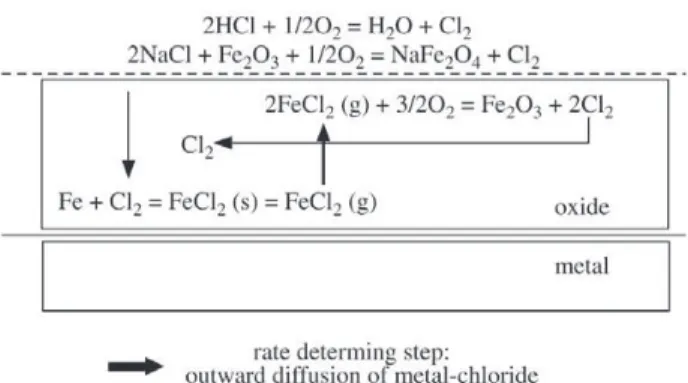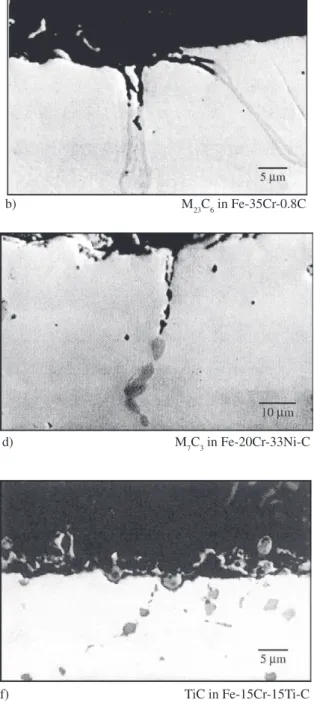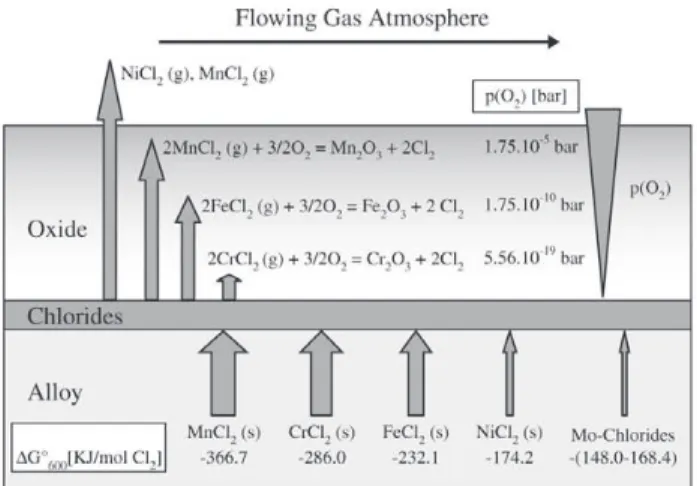*e-mail: grabke@mpie.de
Presented at the International Symposium on High Temperature Corrosion in Energy Related Systems, Angra dos Reis - RJ, September 2002.
Role of Alloying Elements and Carbides in the
Chlorine-Induced Corrosion of Steels and Alloys
Hans Jürgen Grabke*, Michael Spiegel, Armin Zahs
Max-Planck-Institut für Eisenforschung Max-Planck-Straße 1, D-40237 Düsseldorf, Germany
Received: September 2, 2002; Revised: September 4, 2002
The high temperature corrosion of steels and Ni-base alloys in oxidizing and chloridizing environments is of practical interest in relation to problems in waste incineration plants and power plants using Cl containing fuels. The behaviour of the most important alloying elements Fe, Cr, Ni, Mo, Mn, Si, Al upon corrosion in an oxidizing and chloridizing atmosphere was elucidated: the reactions and kinetics can be largely understood on the base of thermodynamic data, i.e. free energy of chloride formation, vapor pressure of the chlorides and oxygen pressure pO2 needed for the conversion chlorides → oxides.
The mechanism is described by ‘active oxidation’, comprising inward penetration of chlorine into the scale, formation of chlorides at the oxide/metal interface, evaporation of the chlorides and conversion of the evaporating chlorides into oxides, which occurs in more or less distance from the surface (depending on pO2). This process leads to loose, fragile, multilayered oxides which are
unprotective (therefore: active oxidation). Fe and Cr are rapidly transferred into such scale, Ni and Mo are relatively resistant.
In many cases, the grain boundaries of the materials are strongly attacked, this is due to a susceptibility of chromium carbides to chloridation. In contrast the carbides Mo2C, TiC and NbC
are less attacked than the matrix.
Alloys on the basis Fe-Cr-Si proved to be rather resistant, and the alloying elements Ni and Mo clearly retard the attack in an oxidizing and chloridizing environment.
Keywords:chloridation, active oxidation, model alloys, alloying elements, carbides
1. Introduction: Reactions and mechanisms
Oxidation can be considerably accelerated in presence of chlorine, hydrogen chloride and chlorides, this is a problem in waste incineration plants and power plants fired with chloride containing coal. Chlorine formation occurs from HCl through catalysis by oxide scales
2HCl + ½ O2 = H2O + Cl2 (1)
or from chlorides by reaction with oxides such as Fe2O3
2NaCl + Fe2O3 + ½O2 = Na2Fe2O4+ Cl2 (2)
Chlorine can somehow diffuse through oxide scales rapidly and reacts at the interface oxide/metal to chlorides of Fe, Ni and the other alloying elements, e.g.
Cl2 + Fe → FeCl2 (s) → FeCl2 (g) (3)
FeCl2 (s) has a vapor pressure at 500 °C of 5 × 10-4 bar, and will evaporate steadily. The FeCl2 (g) passes through cracks and pores of the scale outwards, and when reaching regions with sufficient oxygen pressure it is oxidized according to
FeCl2 (g) + 3/2 O2 = Fe2O3 + Cl2 (4)
90 Grabke et al. Materials Research
dense protective scale (passivation) but to an active, accelerated corrosion1-2.
The chlorine plays a catalysing role and often is not easily found in failure case studies3. In a detailed study of effects of chlorides on the oxidation of a low alloy steel it was shown that the outward diffusion of the gaseous FeCl2 (g) is rate determining for this corrosion process4-5. ‘Active oxidation’ also takes place on high alloy steels5-6 under formation of voluminous non protective scales. These steels also show a typical grain boundary attack under oxidizing and chloridizing conditions, i.e. holes and internal oxides are formed at grain boundaries where chromium carbides had been before3,7.
After these studies on steels, it was of fundamental in-terest how the other alloying elements in steels behave in the ‘active oxidation’ process. Furthermore the reaction of carbides was of interest and both reactions of alloying ele-ments and of carbides in model alloys were studied funda-mentally in an oxidizing and chloridizing atmosphere7-10.
2. Experimental
The experiments were carried out in the temperature range 400 - 700 °C, exposure tests in flowing N2-5% O2-500-1500 vppm HCl and thermogravimetric tests in He-5% O2-500-1500 vppm HCl. The pure elements Fe, Cr and Ni were tested and model alloys Fe-15% Cr - with ei-ther 10% Mn, 10% Mo, 5% Ti, 5% Al or 5% Si and Fe-35% Cr. In some of these materials carbides were genera-ted by addition of 0.3% carbon and an appropriate heat treat-ment. Furthermore some commercial alloys were studied: Alloys 800, 825, 625 and 625 Si9-10.
3. Results
3.1. Pure metals: Fe, Cr and Ni
Thermogravimetric studies on the corrosion of Fe in He-5% O2-500 vppm HCl showed the most severe corro-sion of the three metals. At 400 °C an outer 2-3 µm thick oxide layer and a 6 - 10 µm thick FeCl2(s) layer was ob-served after 168 h. At 500 °C the outer oxide scale is 10 - 15 µm thick and its crystalline, filigrane morphology indicates its formation from the gas phase according to re-action (4). Beneath this layer are grown oxides and chlo-ride at the oxide/metal interface. Most striking is the appearance of the corrosion products after 168 h at 600 °C -the oxide is formed like a dome over -the sample. Its shape corresponds to the stagnant diffusion boundary layer through which FeCl2 (g) diffuses into the region where pO2 is high enough for the conversion FeCl2 (g) → Fe3O4 and Fe2O3. Fe3O4 was found at the interior and Fe2O3 at the outer sur-face of the oxide bubble, FeCl2 (s) on the surface of the metal phase.
On chromium at 400 and 500 °C thin Cr2O3 layers were formed and chlorides were detected only locally. At 600 and 700 °C the scales frequently cracked and spalled as seen in the kinetics. This leads to a multilayered oxide scale see Fig. 2, beneath this scale a layer was detected consist-ing of a mixture of oxide and chloride.
On the nickel sample at 400 °C simultaneous formation of oxides and chlorides occurred. At 500 °C considerable evaporation of NiCl2 leads to paralinear kinetics. Also at 600 and 700 °C NiCl2 evaporation prevails and the evapo-rating chloride is not oxidized near the sample but carried away by the gas flow.
3.2. Binary alloys Fe-15% Cr and Fe-35% Cr
The corrosion of the binary Fe-Cr alloys is strongly de-pendent on the temperature and less on the HCl content (500 or 1500 vppm) of the atmosphere.
At 400 and 500 °C after 168 h, the mass gains by corro-sion are low, protective Cr2O3-scales are formed and only locally destroyed by outgrowth of (Fe, Cr)Cl2 crystals. At 500 °C the Fe-15% Cr alloy already shows indications of active oxidation and enhanced attack, compared to Fe-35% Cr.
At 600 °C the attack on both alloys is very severe, mass gains are higher than for all other alloys studied, even higher than on iron. The adverse features of both, Fe and Cr, in the ‘active oxidation’ are combined: poorly adherent multilayers of oxides are formed due to repeated cracking and spalling. The layers are Fe-rich at their outside (Fe2O3, (Fe,Cr)3O4) and Cr-rich at their inside surface (FeCr2O4, Cr2O3). At the oxide/metal interface the mixed chloride (Fe,Cr)Cl2 was found, and the grain boundaries of the alloys were attacked. Figure 1. Schematics of the reaction circuit in active oxidation of
It was shown that the evaporating chlorides were nearly completely converted to oxides, FeCl2 in the outer part of each layer and CrCl2 in the inner part. The repeated fracture and spalling of the outermost growing layer leads to forma-tion of the special structure, with oxide bubbles and layers, see Fig. 2.
3.3.Ternary alloys Fe-15% Cr-M
Results are reported of exposures in N2-5% O2-500-1500 vppm HCl, mainly at 600 °C for 168 h, see Fig. 3.
92 Grabke et al. Materials Research
the mechanism of the scale growth is the same: formation of a multilayer by active oxidation, repeated cracking and spalling of the layers and formation of oxide bubbles over cracks. The metal phase contains intermetallic compounds Cr6Fe18Ti5 as precipitates and they are preferentially at-tacked, due to the highly negative free energies of Ti-chlo-rides formation.
Fe-15% Cr-10% Mn is less corroded than the Fe-Cr al-loys. A voluminous scale is formed consisting of Fe2O3 and Mn2O3 at its outside and Cr2O3 at the inside, the morphol-ogy similar as in the case of Fe, like large bubbles. In the cavity beneath, the oxygen pressure obviously is low, since its bottom is covered with chlorides, (Mn, Fe, Cr)Cl2 crys-tals for the condition 500 vppm HCl and a CrCl2-layer at 1500 vppm HCl. The latter layer obviously hems the corro-sion, which is less at the higher HCl content.
Fe-15% Cr-10% Mo shows improved corrosion resist-ance compared to the binary Cr alloys. Beneath the Fe-and Cr-oxides in the scale the metal phase is depleted of Fe and Cr and enriched in Mo. Obviously selective corrosion of Fe and Cr has occurred and the Mo reacts much slower, because the free energy of Mo-chlorides formation is less than the values for FeCl2 and CrCl2 formation. This zone of about 5µm thickness is porous and allows the access of the corrosion gases to the uncorroded metal phase, but its pres-ence obviously retards the attack.
Fe-15% Cr-5% Al proved to be very corrosion-resistant in the exposure tests with 500 and 1500 vppm HCl. At the relatively low gas flow velocities a protective scale of
γ-Al2O3 was formed and only locally outgrowth of Fe and
Cr-oxides occurred. This observation already indicates the corrosion resistance may not be reliable. In fact, the thermogravimetric experiments at higher flow velocities showed strong active oxidation under formation of a multi-layered porous scale. Probably at the higher flow velocities the evaporating AlCl3 is transported away before conver-sion to a protective oxide scale. Also differences were ob-served after different surface finish, a ground specimen cor-roded much faster than a polished one.
Most corrosion resistant was the Fe-15% Cr–5% Si al-loy, also at high gas flow velocities. The protection is ef-fected by a thin Cr2O3-rich oxide scale, only locally some iron oxides have grown by active oxidation. An internal layer of SiO2 was not detected, but probably initial formation of such layer and enhanced Cr-diffusion in the alloy have led to formation of the protective scale. Fe-Cr-Si alloys have been tested thoroughly under simulated waste incineration conditions, and they may be used as coatings for effectively improving corrosion resistance11-12.
3.4. Commercial alloys containing nickel
To study the role of nickel, the commercial alloys Alloy 800, i.e. Fe-30.3 Ni-20.3 Cr and Alloy 600 Ni - 16 Cr-8.3 Fe
were tested at 600 °C in the oxidizing-chloridizing atmos-phere. These alloys behave relatively inert compared to the Cr-steels. The mass increase after 168 h is about 1.75 mg/cm2 for Alloy 800 and 0.5 mg/cm2 for Alloy 600 in both atmos-pheres with 500 or 1500 vppm HCl (compared values be-tween 5-50 mg/cm2, see Fig. 3). As in the case of Mo the attack on Ni is less than on Fe and Cr, because the free en-ergy of NiCl2 - formation is much less negative than for FeCl2 and CrCl2. In the alloys 800 and 600 the selective corrosion of Fe and Cr leads to a porous, sponge like structure of the outer zone of the metal phase. The evaporating chlorides FeCl2 and CrCl2 are oxidized above the oxide/metal interface and form a multilayered scale, as in the case of the Fe-Cr alloys, consisting of Fe2O3 and (Fe, Ni) Cr2O4. The morphology of the scale on Alloy 800 is characterized by voluminous oxide bubbles and on Alloy 600 by many thin layers.
The attack by the oxidizing-chloridizing is even more suppressed by additional alloying with Mo, this was shown for Alloy 625, i.e. Ni-22.2 Cr-9.2 Mo-4.6 Fe-3.4 Nb, and for Alloy 625Si, i.e. Ni-20.8 Cr-9.5 Mo-3.2 Fe-1.5 Si, for which the corrosion resistance was best.
3.5. Alloys with carbide precipitates
Well-defined carbides were obtained in ternary Fe-Cr-C and quaternary Fe-Cr-M-C alloys by appropriate heat treat-ments7. These alloys were tested as the others in the oxidiz-ing-chloridizing environment at 600 °C for 168 h.
M23C6 carbides in Fe-15% Cr-0.8% C, Fe-35%
Figure 4. Metallographic cross sections of model alloys with well-defined carbide precipitates after 168 corrosion in N2-O2-HCl at 600 °C. a-d) the chromium carbides M23Cand M7C3 are attacked selectively; e-g) Mo-rich carbide M6C, TiC and NbC are clearly more corrosion resistant than the metal matrix.
a) M23C6 in Fe-15Cr-C b) M23C6 in Fe-35Cr-0.8C
c) M23C6 in Fe-20Cr-12Ni-C d) M7C3 in Fe-20Cr-33Ni-C
e) M6C in Fe-15Cr-10Mo-C f) TiC in Fe-15Cr-15Ti-C
94 Grabke et al. Materials Research
mens as gaseous reaction products. this is possible by the reaction which has a considerably negative free energy.
Cr23C6 + 23 Cl2 + 3 O2 = 23 Cr Cl2 (g) + 6 CO (g) (5)
Also M7C3 obtained by heat treatment of Fe-20% Cr-33% Ni-0.5% C is attacked preferentially and the corrosion leaves cavities along the grain boundaries (Fig. 4d). So the chro-mium carbides M23C6 and M7C3 are weak components in the corrosion of alloys in oxidizing-chloridizing conditions. Often failure cases have been reported where the grain boundary attack in such environment is due to the grain boundary carbides in high temperature steels and alloys.
In contrast other carbides such as Mo6C, TiC and NbC prepared in Fe-15% Cr-10% Mo-0.3% C, Fe-15% Cr-5% Ti-0.3% C and Fe-18% Cr-10% Ni-0,8% Nb-0.1% C, be-haved better corrosion resistant than the matrix. These car-bides remain nearly unattacked even after the surrounding metal matrix has corroded, see Fig. 4e-g. This observation was surprising since also for these carbides the reactions leading to volatile chlorides and CO have negative free en-ergies. So the reason for the stability of TiC, NbC and Mo6 in the oxidizing-chloridizing environment is not clear as yet.
4. Discussion
The corrosion behaviour of the alloying elements in oxidizing-chloridizing environments can be discussed and explained largely by thermodynamic data (see Fig. 5):
• The Gibbs’ free energy of the reaction metal + chlorine ® metal chloride. The more negative this value the faster is the reaction with this element in the metal matrix and the corrosion attack occurs accord-ing to the sequence Mn > Cr > Fe > Ni > Mo. • The oxygen pressure for the conversion of the
evapo-rating chlorides into oxides, e.g. reaction (4). The lower this oxygen pressure, the smaller is the distance from the metal surface at which the oxide is formed. Therefore the oxide layers are Fe-rich at their outside and Cr-rich at their inside, and the Ni- and Mo-chlo-ride are transported away to a great part unoxidized by the gas flow.
• The vapor pressures of the chlorides, they also play a role for the destiny of the corrosion products, evapo-ration or oxidation.
5. Conclusions
The corrosion of metals and alloys in oxidizing-chloridizing environments occurs by ‘active oxidation’4-6, i.e. the reaction steps: i) formation of Cl2 from HCl or chlo-rides in and on the oxide scale, ii) penetration of Cl2 into the scale and reaction to metal chlorides at the metal phase, (iii) outward diffusion of metal chlorides through the scale
and (iv) oxidation of the chlorides to crystalline, porous oxides, where a region with a sufficient pO2 is reached in or over the scale. The Cl2 reenters the scale, so the active oxi-dation is a circuit catalysed by chlorine, leading to an unprotective oxide scale.
The reaction of Cl2 with the alloying elements8-10 is the faster the more negative the free energy of chloride forma-tions is, Cr, Fe and Mn are attacked strongly, whereas Ni and Mo react slowly and behave rather inert. From Ni and/or Mo rich alloys the other alloying elements are reacted se-lectively and a porous Ni and Mo rich metal layer remains. Thus Ni and Mo are favourable for the corrosion resistance of alloys in oxidizing-chloridizing environments.
On Cr, Fe-Cr and Fe-Cr-M alloys (M = Ti, Mn) friable unprotective scales are formed. Layers of Cr2O3, spinels and Fe2O3 result from the evaporation and oxidation of FeCl2 and CrCl2, oxide bubbles arise where such layers are crack-ing and repeated spallcrack-ing and crackcrack-ing leads to a multilay-ered scale. Si and Al as alloying elements M can signifi-cantly retard this corrosion process. Fe-Cr-Si alloys are rec-ommended as protective coatings in oxidizing-chloridizing environments11-12.
Chromium carbides M7C3 and M23C6 are strongly attacked in oxidizing-chloridizing environments, this leads to grain boundary corrosion of alloys with such grain boundary car-bides, starting from the surface7-10. Since gaseous reaction products, CrCl2 and CO, are formed, holes are left in the metal matrix and internal oxidation follows. Other carbides such as Mo6C, TiC and NbC are more corrosion resistant than the alloy matrix and stay uncorroded. Accordingly, presence or formation of chromium carbides should be avoided in alloys applied in oxidizing-chloridizing environments.
References
1. McNallan, M.J.; Liang, W.W.; Kim,S.H.; Kong, C.T. in
“High Temperature Corrosion”, R.A. Rapp ed., NACE, 136, 1983.
2. Lee, Y.Y.; McNallan, M.J. Metallurg. Trans 18A, 1099 (1987).
3. Grabke, H.J.; Müller, E. Werkstoffe u. Korr. 41, 226 (1990).
4. Reese, E.; Grabke, H.J. Werkstoffe u. Kor. 44, 41 (1993). 5. Grabke, H.J.; Reese, E.; Spiegel, M. Corros. Sci 37, 1023
(1995).
6. Reese, E.; Grabke, H.J.; Werkstoffe u. Korr. 43, 547 (1992).
7. Berztiss, D.; Zahs, A.; Schneider, A.; Spiegel, M.; Viefhaus, H.; Grabke, H.J. Z. Metallkd. 90 1 (1991). 8. Zahs, A.; Spiegel, M.; Grabke, H.J. Materials & Corr.
50, 561 (1999).
9. Zahs, A. Chlorinduzierte Hochtemperaturkorrosion in oxidierenden Atmosphären. Fortschritt-Berichte VDI, Reihe 5, Nr. 551, VDI Verlag GmbH, Düsseldorf, (Dr.-Thesis) 1999.
10. Zahs, A.; Spiegel, M.; Grabke, H.J. Corros. Sci. 42, 1093 (2000).
11. Schroer, C. Entwicklung neuer Werkstoffe zur
Verlängerung der Standzeit von Wärmetauschern in Müllverbrennungsanlagen. Shaker Verlag Aachen (Dr. Thesis) 2001.
12. Schroer, C.; Spiegel, M.; Grabke, H.J.; Sauthoff, G.


